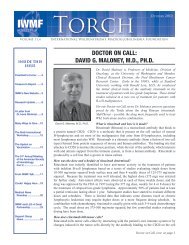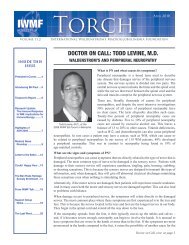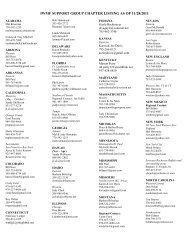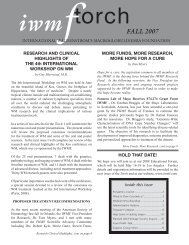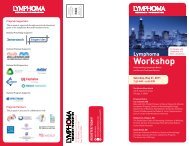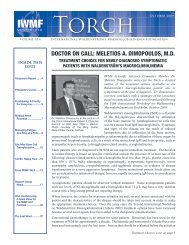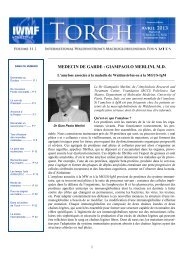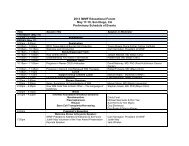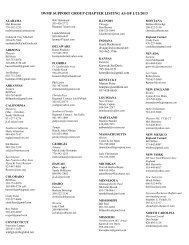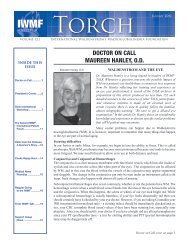English - International Waldenstrom's Macroglobulinemia Foundation
English - International Waldenstrom's Macroglobulinemia Foundation
English - International Waldenstrom's Macroglobulinemia Foundation
Create successful ePaper yourself
Turn your PDF publications into a flip-book with our unique Google optimized e-Paper software.
MEDICAL NEWS ROUNDUP<br />
b y Sue Herms, IWMF Trustee<br />
Ibrutinib Receives Breakthrough Therapy Designation<br />
for WM – Ibrutinib, an oral inhibitor of Bruton’s tyrosine<br />
kinase (BTK), was recently granted Breakthrough Therapy<br />
Designation by the U.S. Food and Drug Administration<br />
as single agent therapy for the treatment of WM and of<br />
relapsed/refractory mantle cell lymphoma. Breakthrough<br />
Therapy Designation is intended to expedite the development<br />
and review of new drugs for serious or life threatening<br />
diseases when preliminary clinical evidence indicates that<br />
the drugs may demonstrate substantial improvement over<br />
existing therapies. BTK is involved in regulating apoptosis<br />
(programmed cell death), adhesion, and cell homing and<br />
migration. Through these actions, BTK directs malignant<br />
cells to lymphoid tissues, providing an environment<br />
necessary for their proliferation. Ibrutinib was developed by<br />
Pharmacyclics and Janssen Biotech and specifically targets<br />
BTK; it first entered the clinical trials process in 2009.<br />
Dose Escalation Study of Ibrutinib Reported – One of<br />
several studies of ibrutinib that led to its Breakthrough<br />
Therapy Designation for WM and mantle cell lymphoma<br />
was a multicenter U.S. trial reported by Dr. Ranjana Advani<br />
of Stanford University Medical Center. In this study, 56<br />
patients with relapsed or refractory B-cell lymphoma and<br />
chronic lymphocytic leukemia received escalating oral doses<br />
of ibrutinib in two dosing schedules. Most adverse effects<br />
were of relatively low severity and self-limited. Doselimiting<br />
events were not observed, even with prolonged<br />
dosing. Dose escalation continued to 12.5 mg/kg per day<br />
without reaching the maximum tolerated dose. The response<br />
rate was 60%, including a complete response rate of 16%,<br />
and median progression-free survival was 13.6 months.<br />
Nimbus Reports Synergistic Effects of IRAK4 Inhibitors<br />
with Ibrutinib – Nimbus Discovery LLC presented preclinical<br />
data showing that its novel IRAK4 inhibitors (ND-<br />
2110 and ND-2158), when combined with ibrutinib, work<br />
synergistically to cause selective cell death in blood cancers<br />
with the activating MYD88 L265P mutation. This mutation is<br />
prevalent in WM patients, determined in studies first reported<br />
by Dr. Steven Treon at Dana-Farber Cancer Institute. The<br />
Nimbus findings were generated in collaboration with Dr.<br />
Louis M. Staudt at the National Cancer Institute. Nimbus<br />
expects to initiate clinical trials with these drugs in 2014.<br />
Bendamustine Treatment Evaluated for AL Amyloidosis<br />
– A joint Italian-German study evaluated the safety and<br />
efficacy of bendamustine and prednisone in 36 patients with<br />
AL (amyloid light-chain) amyloidosis. Amyloidosis is a<br />
progressive incurable disease characterized by abnormal<br />
deposits of proteins in one or more tissues or organs. Ten<br />
of these patients (28%) had IgM clones, and 8 of the 10<br />
also received rituximab with the bendamustine/prednisone<br />
therapy. The target dose of bendamustine was 100 mg/m 2 ,<br />
although lower doses were used in patients with cytopenias<br />
(reductions in the normal number or red blood cells, white<br />
blood cells, or platelets). Among the subjects with IgM<br />
clones receiving the treatment combined with rituximab, 6<br />
patients (75%) responded. Overall, 33% of patients died, and<br />
65% are alive after three years. The study concluded that<br />
bendamustine is effective and well tolerated and represents<br />
an additional treatment option in AL amyloidosis.<br />
Chlorambucil Compared to Fludarabine in Phase III<br />
European Trial – A multicenter European study reported<br />
Phase III results of a randomized trial of chlorambucil vs.<br />
fludarabine for patients with untreated WM, marginal zone<br />
lymphoma, and lymphoplasmacytic lymphoma. Of the 414<br />
patients enrolled, 339 had WM. The overall response rate was<br />
47.8% in the fludarabine arm vs. 38.6% in the chlorambucil<br />
arm. With a median follow-up of 36 months, progressionfree<br />
survival and duration of response were significantly<br />
improved in the fludarabine arm. In WM patients, median<br />
overall survival was not reached in the fludarabine arm.<br />
Grade 3-4 neutropenia was significantly higher and second<br />
malignancies were significantly lower with fludarabine<br />
than with chlorambucil. The study's conclusion was that<br />
fludarabine significantly improved progression-free survival<br />
compared to chlorambucil, and in patients with WM, it<br />
improved overall survival.<br />
Researchers Study Nuclear Protein Expression in WM/<br />
LPL – Researchers at Northwestern University and the<br />
University of Chicago looked at the expression of nuclear<br />
proteins in WM/LPL (lymphoplasmacytic lymphoma) cells.<br />
In this study, the expression patterns of these proteins were<br />
analyzed in plasma cells and lymphocytes in 29 newly<br />
diagnosed patients. These patterns were compared to the<br />
expression profiles seen in normal bone marrow samples,<br />
reactive tonsils, and cases of multiple myeloma and<br />
marginal zone lymphoma. The percentage of plasma cells<br />
co-expressing CD138 and PAX5 was significantly higher<br />
in WM/LPL compared with benign tissues, marginal zone<br />
lymphoma, and multiple myeloma whereas the percentage<br />
of plasma cells co-expressing CD138 and MUM1 was lower<br />
in WM/LPL. The finding of relatively increased PAX5<br />
expression and decreased MUM1 expression suggests that<br />
components of B-cell expression are abnormally persistent<br />
in WM/LPL plasma cells. This nuclear protein expression<br />
pattern could be an aid in the differential diagnosis of WM/<br />
LPL as well as a clue to disease pathogenesis.<br />
New Experimental Treatment for Chemotherapy-Induced<br />
Peripheral Neuropathy Advances – DARA Biosciences,<br />
Inc., has submitted an Orphan Drug Application to the U.S.<br />
Food and Drug Administration for KRN5500, a treatment in<br />
development for painful and chronic chemotherapy-induced<br />
Medical News, cont. on page 11<br />
8 IWMF TORCH Volume 14.2



